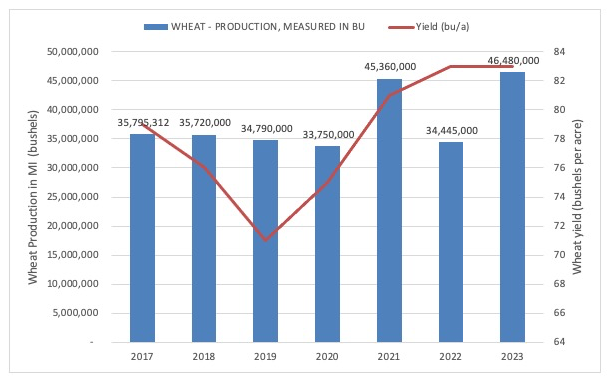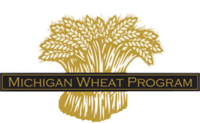Lansing, Mich. (March 31, 2024) – Following last month’s Winter Annual Meeting and the newly released planting intentions from the National Ag Statistics Service (NASS), the Michigan Wheat Program along with the Michigan State University (MSU) wheat systems specialist have put together a very optimistic outlook for the 2024 winter wheat crop.
Questions have been rolling in from wheat producers and industry representatives alike, wondering about the impacts of the unseasonably mild 2023-2024 winter on this year’s crop. MSU’s wheat specialist, Dennis Pennington noted that while dormancy had broken a couple weeks ago, green-up of the crop had not occurred in most parts of the state. At the same time, there has been no widespread “ponding” in wheat fields that can damage wheat’s growing point and ultimately diminish yields.
“We have issued ‘adjusted’ recommendations for nitrogen and herbicide applications because the growing degree indicators showed us the warmer weather hadn’t pushed much wheat into the green-up stage,” said Pennington. “In fact, the late onset of sub-freezing temperatures last November allowed even the late-planted wheat to have tiller development – which doesn’t always happen and was a very good thing given that many acres were planted late.”
“The bottom line is: Even though wheat was planted later than optimal in some locations, the crop still looks good across the state,” Pennington said.
Michigan traditionally produces an average of 81 bushels/acre, significantly above the 2023 national average of 50.6 bushels/acre according to NASS. This large yield is due to soil types, natural rainfall due to the Great Lakes effect and a strong focus on wheat as a bottom-line crop with a strong home-state miller advantage; the state has five wheat mills.
Recently, the USDA National Agricultural Statistics Service (NASS) Great Lakes released a report of wheat acres planted. It shows a decrease in the acres planted, but acreage is just one part of the story. The other half of the equation is the bushel per acre yield, said Michigan Wheat Program executive director Jody Pollok-Newsom.
“In five of the last seven years, Michigan’s wheat production has remained steady at 35 million bushels, with production ticking up in two of those years,” Pennington commented. “In those five years, yields increased by nearly 17%. When I run the numbers of harvested acres and the yield trend, I end up with a crop of 33 million bushels. This is down about 5% from our trend average.”
“Of course, weather will play a role in determining the final number of acres harvested and the average yield, but Michigan wheat is in good shape, actually much better shape than some thought we would be this early in spring,” he said

Above: USDA National Agriculture Statistics Service data from 2017 to 2023 for Michigan wheat production and yield.
Pollok-Newsom commented that Michigan wheat yields are heading up.
“Not only do we have higher yields than other states, but our growers are participating in the collaborative program with Ontario called the Great Lakes Yield Enhancement Network, or YEN,” she said. “One aspect of the Great Lakes YEN is a yield contest where we had growers achieving 2022 yields above 160 bushels/acre. This was achieved in the “thumb of Michigan” where winter white wheat is king.”
“The Michigan Wheat Program is very optimistic about the YEN results for the 2024 harvest given the strong white wheat crop at this moment,” Pollok-Newsom said. “We anticipate that white winter wheat is about 35-40% of our total wheat crop.”
Michigan’s planted wheat acreage was down in the fall of 2023 due to late-harvested corn and soybeans, yet at this point both red and white winter wheat appear to have benefitted from favorable fall and winter weather.
“Given the observations of our wheat specialist Dennis Pennington, who has traveled the state looking at his research plots and growers’ fields, we are expecting another good size crop with a higher-than-average percentage of planted acres harvested,” Pollok-Newsom concluded.
The Michigan Wheat Program is funded by nearly 8,000 farmers who grow wheat in the Great Lakes state. The Michigan Wheat Program board seeks to promote the state’s wheat industry by funding and supporting the strategic priorities of wheat farmers working with input suppliers, seed producers, millers, end users and consumers. Research on wheat production practices and grower education has been a continued focus for the organization.
